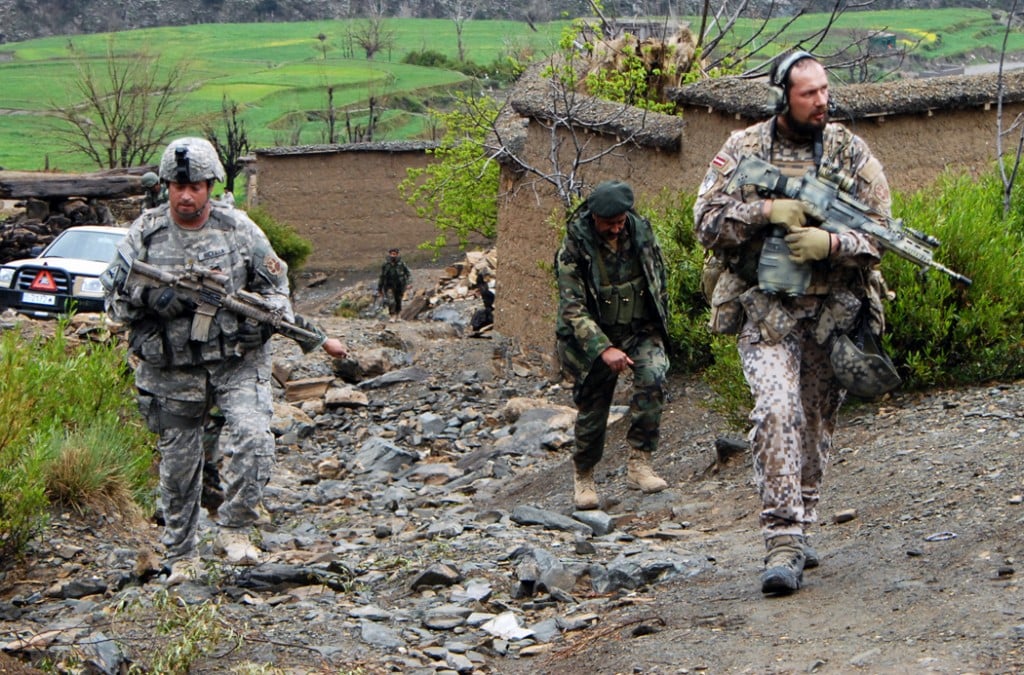Guard Association Says Compromise With Army Possible
Posted on

A Michigan National Guard soldier patrols in Afghanistan alongside an Afghan soldier and a Latvian ally.
After more than two months of escalating conflict, the powerful National Guard Association of the US downshifted today and took a markedly more conciliatory tone towards the Army leaders it had been savaging just last week. As Army Sec. John McHugh and Chief of Staff Gen. Ray Odierno testified before the House Armed Services Committee, NGAUS president Gus Hargett, a retired general himself, issued a supportive statement headlined “NGAUS, Army Leaders Agree on Most Issues.” The statement still ended by criticizing the active-duty Army for not heeding the Guard’s needs during the internal Pentagon budget process, but even this passive-aggressive note was a long way from the just plain aggressive, even inflammatory rhetoric of the past ten weeks.
Is this shift just tactical? Or, I asked NGAUS spokesman John Goheen on Tuesday evening, does this new, conciliatory tone signal a new, conciliatory strategy?
There’s “no shift in strategy,” Goheen said. “Our top priority,” he said, is still convincing Congress to put the Pentagon’s planned cuts to the Army Guard on hold and create an independent commission to resolve the issue.
That said, “we want people to know there’s broad agreement between us and the Army on a lot of things,” Goheen went on. “We’ve been very focused on the issues that divide us, [but] we’re not at loggerheads on everything.”
“The Chief of Staff of the Army is our chief of staff, the Secretary of the Army is our Secretary of the Army,” Goheen said. (Compare recent NGAUS lambastings of “Army leaders” generally and Gen. Odierno personally).
Yes, Hargett’s statement made the differences clear in its stinging final paragraph: “The problem is, the give and take that is an essential part of such an effort never occurred in the development of the fiscal 2015 Army budget request now before Congress, which is why there is so much public disagreement between Guard and Army leaders today.”
NGAUS nevertheless took unusual pains to emphasize they were fighting the Army on a narrow front, not a broad one. “We have a disagreement about…. the exact balance that needs to be struck” between the size of the regular active-duty and the size of the Army National Guard, Goheen said. But NGAUS agrees with the Army leadership on what he called the “larger issues”: the need for a strong ground force with modernized weapons and high readiness, all things that both NGAUS and the Army — and many in Congress — agree are at risk from the automatic budget cuts known as sequestration.
“Doing something about sequestration certainly is a NGAUS priority,” Goheen said. “Right now, in terms of representing our members, our top priority is an Army commission.” (Emphasis mine). There are plenty of groups campaigning to roll back the sequester, he said, but only one NGAUS: “We speak for the Guard.”
“Even if we were to find some kind of agreement on sequestration chances are we’re still looking at some austerity in the years ahead,” Goheen noted. “And we believe the Guard provides some real solutions in this kind of fiscal environment with sequestration or without sequestration because [it has] proven capabilities at a lower cost…..When you start cutting the Army National Guard, you’re cutting capability at minimal cost savings.”
Capitol Hill is very friendly territory for the Guard. So far, a bill by Rep. Joe Wilson calling for a commission, HR 3930, has 139 co-sponsors — respectable but hardly a revolution. Goheen emphasized NGAUS was backing the bill but remained open to alternatives. Even though the Army has already submitted its budget to the Hill, the regular active duty leadership still could come to terms with the Guard in ways that would make a commission unnecessary, Goheen told me, at least in theory. Even at this late date, he said, “there could be some sort of settlement, some sort of compromise.”
Subscribe to our newsletter
Promotions, new products and sales. Directly to your inbox.
